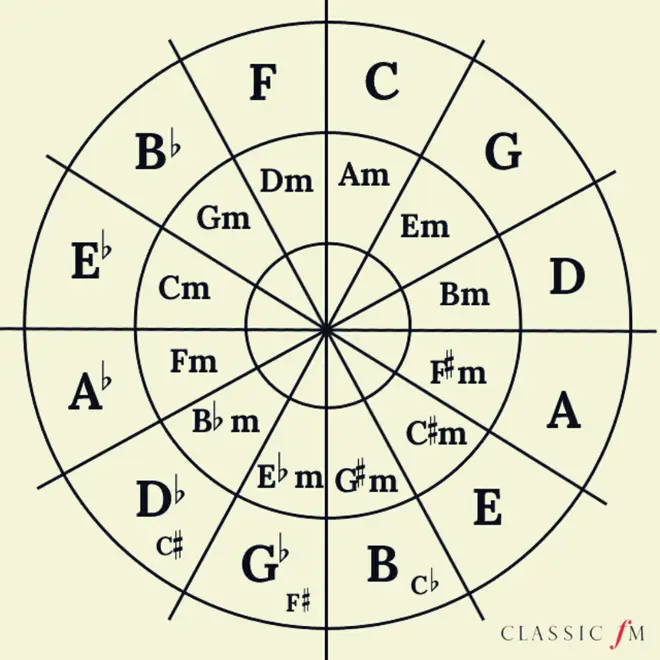In music theory, the circle of fifths is an essential tool that helps musicians understand the relationship between keys and the organization of musical scales. It is a circular diagram that illustrates the relationships between the twelve pitches of the chromatic scale, their corresponding key signatures, and the intervals between them.
The Construction of the Circle of Fifths
To construct the circle of fifths, we start with the key of C major at the top of the circle. Moving clockwise, each key is a fifth higher than the previous one. This means that each key shares six out of seven notes with its adjacent keys, with only one note changing with each progression. The circle is completed once we reach the key of C major again, but this time in the next octave.
| Key | Sharps | Flats |
|---|---|---|
| C | 0 | 0 |
| G | 1 | 0 |
| D | 2 | 0 |
| A | 3 | 0 |
| E | 4 | 0 |
| B | 5 | 0 |
| F# | 6 | 0 |
| C# | 7 | 0 |
| F | 0 | 1 |
| Bb | 0 | 2 |
| Eb | 0 | 3 |
| Ab | 0 | 4 |
| Db | 0 | 5 |
| Gb | 0 | 6 |
| Cb | 0 | 7 |
The table above showcases the number of sharps or flats in each key. As mentioned earlier, each key shares six out of seven notes with its adjacent keys, meaning they have a close relationship in terms of musical structures and tonality.

Credit: en.wikipedia.org
The Circle of Fifths and Key Signatures
Key signatures are a fundamental aspect of music notation. They consist of sharps or flats placed at the beginning of a line or measure to indicate which notes are altered throughout the piece. The circle of fifths provides a visual representation of the relationship between the keys and their respective key signatures.
Each key, as it progresses clockwise around the circle, adds one sharp to its signature. For example, the key of C major has no sharps or flats, while the key of G major has one sharp. This pattern continues until we reach the key of F# major, which has six sharps.
On the other hand, each key, as it progresses counterclockwise around the circle, adds one flat to its signature. Following this pattern, the key of C major has no sharps or flats, while the key of F major has one flat. The circle continues until we reach the key of Cb major, which has seven flats.

Credit: www.classicfm.com
Functionality of the Circle of Fifths
The circle of fifths has several practical uses in music theory and composition. Here are a few notable examples:
- Key Progressions: The circle of fifths helps musicians determine the most harmonically pleasing progression of keys. Moving clockwise around the circle allows for smooth transitions by following the natural resolution pattern.
- Modulation: Modulation is the process of changing from one key to another within a musical piece. The circle of fifths aids in identifying compatible keys for modulation, as keys that are adjacent on the circle share many tonal and structural characteristics.
- Chord Progressions: Many chord progressions in music are based on the circle of fifths. Musicians often use chord progressions that move in fifths to create a sense of harmonic movement and stability.
- Transposition: Transposing a piece of music involves changing the key while maintaining the same harmonic structure. The circle of fifths helps musicians transpose accurately by showing the relationships between different keys.
- Composition and Improvisation: Composers and improvisers use the circle of fifths to select chords, scales, and melodic patterns that work harmonically and melodically. It serves as a guide, ensuring coherent musical ideas.
The circle of fifths acts as a fundamental tool in music theory, aiding musicians in understanding the relationships between keys, key signatures, and tonality. Its application extends to various musical aspects, such as chord progressions, modulation, and transposition. By utilizing the circle of fifths, musicians can enhance their musical compositions and improvisations while maintaining a strong harmonic structure.
Frequently Asked Questions Of How Is The Circle Of Fifths Used In Music Theory?
How Is The Circle Of Fifths Beneficial In Music Theory?
The Circle of Fifths helps musicians understand key relationships, chord progressions, and modulation.
Why Is The Circle Of Fifths Essential For Learning Music Theory?
It provides a visual representation of the relationship between keys, aiding in understanding scales and chord progressions.
What Is The Significance Of The Circle Of Fifths In Composition?
It assists composers in creating harmonious chord progressions and choosing key modulations for creating musical tension and resolution.
How Does The Circle Of Fifths Aid In Understanding Key Signatures?
It simplifies the process of identifying and memorizing key signatures, making it easier to comprehend tonal relationships.